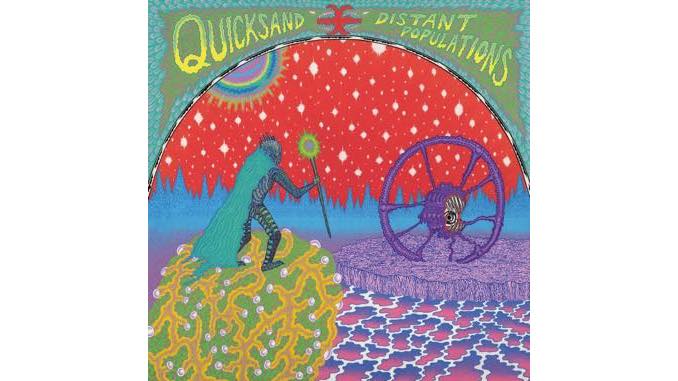When Quicksand first got together in 1990, the collective resumé of the then-upstart group’s members included more than half a dozen hardscrabble New York-area hardcore outfits like Youth of Today, Gorilla Biscuits and Burn. As a result, Quicksand screeched into existence shrouded in an aura of preordained street credibility that persists to this day. However, frontman/bandleader Walter Schreifels—a scene veteran by the ripe old age of 20—set out to buck hardcore convention with a more open, melodic, flexible sound that incorporated elements of metal. Believe it or not, his intention was actually to create a rap-metal hybrid. Quicksand didn’t quite turn out that way, but Schreifels and his bandmates landed on a formula that bypassed barriers and then some.
Right out of the gate, Quicksand’s style appealed to supporters of independent-minded groups steeped in underground ethics who nevertheless saw hardcore as a jumping-off point—Fugazi, Jawbox, Helmet, Drive Like Jehu and just about any band tagged as “post-hardcore.” The appeal extended even further, though. Quicksand’s 1993 full-length debut Slip, one of only two albums they released before calling it quits in ‘95, also resonated with fans of metal-adjacent acts who harbored no reservations about gunning for maximum commercial success—tourmates, for example, like Rage Against The Machine, Living Colour and White Zombie.
Quicksand’s crossover potential didn’t stop there, either. At times, thanks in large part to the ingenious heroics of former lead guitarist Tom Capone, the band’s atmosphere-heavy style verged on space rock. And though it would be somewhat off-target to label Quicksand as emo, per se, if you were to draw a line from Rites of Spring to Sunny Day Real Estate to The Get Up Kids, it’s hard to deny the commonalities. It should come as no surprise, then, that Distant Populations, Quicksand’s second post-reunion album (and fourth overall), charts a course that’s light years away in outlook and temperament from the angsty style that secured the band’s legend.
Quicksand were never purists, so it stands to reason that maturity would reflect new shades of a group who possessed manifold shades to begin with. And when the band finally released long-awaited new material with 2017’s Interiors, the shift towards a more vaporous, introspective style felt like a radical departure from the gnashing attack of 1995’s Manic Compression—about what you’d expect following a 22-year gap between records. But since Distant Populations treads much of the same ground as Interiors—gauzy mixes render the two albums virtually indistinguishable—it’s now evident Quicksand can no longer stay one step ahead of time forever.
On Distant Populations, in fact, Schreifels, bassist Sergio Vega and drummer Alan Cage find themselves facing the same conundrum as the rest of us, which is that age takes away as much as it gives. “I remember when we were 17 / There was nothing we wouldn’t dare,” Schreifels sings on “EMDR,” an admirable attempt to marry Quicksand’s vintage muscular riffing style to a more sensitive frame of mind. Schreifels’ ghostly wail on the chorus recalls Chino Moreno of the Deftones—who were themselves enamored by Quicksand early on (so much so that they eventually recruited Vega to join them in 2009). But the slosh of compressed cymbals and melodic singing raises the concern that Quicksand may have fallen into the featureless miasma one encounters on pre-curated playlists. If “EMDR” popped up unexpectedly in the listening queues of longtime fans, it’s questionable whether they would even recognize who it was.
Which isn’t to say that Schreifels, Vega and Cage aren’t aging gracefully. The melancholy mood of “Brushed,” an electro-tinged acoustic number, arguably gets as enveloping as the unbridled roar of the old stuff. The clipped drum loop actually captures Cage’s ever-taut, assertive style, while Vega positions his rumbling bass in such a way that it doesn’t smother Schreifels’ haunted vocal. Despite his underground pedigree, Schreifels doesn’t hold back when accessibility is his goal. If you listen to “Hostage Calm,” a song intended for an unfinished third album that broke the band up a second time in 1999, it’s clear that Quicksand had at least an outside shot of conquering the airwaves at the height of the ”modern rock” format’s dominance.
Apparently, Schreifels always had it in him to rival the likes of Rivers Cuomo and Billy Corgan. But where he was able to inject screaming with unprecedented levels of tunefulness in the past, these days, he goes all the way, opting instead to sing. All three players, in fact, are known for approaching their instruments in highly distinct ways, and the chemistry between them played a huge role in why Quicksand struck such a chord back in the day. “Missile Command” and album closer “Rodan” transplant that chemistry into fertile creative soil that points in a droney direction. Both songs suggest that Quicksand still have more ground to explore. Meanwhile, the “It’s … all … done … with mirrors” bridge section of “Lightning Field” showcases the piston-like start-stop technique that fans will immediately recognize.
At times, it’s the band’s familiar tactics that show how moving Quicksand can be now that youthful piss and vinegar isn’t the primary motivator. Thankfully, Schreifels’ lyrics appear to have caught up with his intellect. (Just watch any interview clip to see how reflective and astute he can be while, say, comparing hardcore music to cabinet-making.) This is a welcome development because—let’s face it—in this day and age, we’ve all got bigger fish to fry than people we perceive to be poseurs vying to get on the guestlist. In truth, Distant Populations is actually heavier in spots than its predecessor, with more driving grooves, more riffs, and mushroom-cloud explosions. Still, after being set up by Interiors, it’s hard not to feel like something’s missing—namely, Capone.
In 1995, just prior to breaking up—and just as pop-punk mania was starting to crest—the band headlined the inaugural Warped Tour on a bill that also featured Sublime, No Doubt, L7 and Sick Of It All. Surviving footage of a near-complete set from that outing showcases the vitality that no doubt made loyalists out of some in attendance who expected to pogo along to sugar-coated punk choruses all day long. In that clip, the connection between all four members practically burns off the screen. It would be unfair to expect that same fire from Quicksand circa 2021—it would actually be disastrous for the band to pretend that a quarter-century hasn’t passed since then. Wisely, the intention with Interiors wasn’t to recapture the old essence, but to “re-contextualize” it. So the stylistic changes and newfound temperance make perfect sense.
But watching old live footage—even from reunion shows over the five years leading up to Interiors—it’s hard to ignore the fact that Quicksand were never a band whose mission you questioned. The drive was always squarely in your face in a visceral way. Today, even missing a crucial member, Schreifels, Vega and Cage still have some new tricks up their sleeve. Lack of creativity, then, isn’t so much the issue. But where Interiors had a radical freshness working in its favor, there’s an aimlessness to the way the band now drifts between softer, more modern motifs and its established vocabulary of riffs. With Distant Populations, Quicksand for the first time sound like a band who don’t necessarily know where their drive comes from anymore.
Like some kind of musical unicorn, Quicksand crafted a sound that oozed punk aggression and righteousness while also benefiting from an accessibility that most of their peers flat-out lacked. A more mature Quicksand is thus a welcome thing to count on these days. They abruptly broke up twice in the past, which painfully left fans wanting more, but it also heightened the mystique. Unless they find a way to anchor their new music in a re-calibrated sense of purpose, Schreifels, Vega and Cage risk losing the power that made their classic work so alluring. They also risk settling into a space where we can take them for granted—an indignity far less than what a band with such a valuable legacy deserves.
Saby Reyes-Kulkarni is a longtime contributor at Paste. He believes that a music journalist’s job is to guide readers to their own impressions of the music. He also dreams of being a “setlist doctor” to the bands you read about in these pages, and has started making playlists for imaginary shows that your favorite band never actually played. You can read his work, listen to his interviews and playlists at feedbackdef.com, and find him on Twitter.




